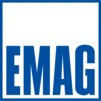
#Product Trends
Additive Manufacturing Provides Greater Precision in Induction Heating
Innovation at EMAG eldec
Traditionally, inductors for induction heaters must be produced using a very sophisticated manufacturing process. Despite the many years of experience and great craftsmanship from those who manufacture these precision tools, there are certain limitations to this manufacturing method. All handcrafted products generally have slight deviations. Even if these can be compensated for without any problem, they still frequently require corrections when it comes time to change the tool. All machine setters are aware of this, even when machining by stock removal. Another limiting factor is the inductor’s size. The smaller and more complex an inductor is, the more elaborate its production becomes— until it can no longer be handcrafted. This was the status quo for a long time until a new manufacturing process involving additive manufacturing was developed, advancing entirely new dimensions of induction heating.
Dr. Dirk Schlesselmann, Head of R&D for Application Technology at EMAG eldec, is eagerly glancing at the laser that is running over the machine’s powder bed. The contour of an inductor winding, produced using the Selective Laser Melting (SLM) process, is slowly taking shape from the powder.
“This is one of the most thrilling innovations to me,” explains Dr. Schlesselmann. “I can switch from design to the production of an inductor winding with just one intermediate step.”
The machine data for additive manufacturing are prepared during this intermediate step—this is known as preprocessing. Optimal surface quality, dimensional accuracy and tool life can only be guaranteed if the winding is correctly aligned within the machine’s installation space.
On average, the production of an inductor winding takes 8 to 16 hours. The tool is manufactured from a copper alloy, and then must be subjected to a heat treatment to establish the material’s optimal electrical conductivity. The winding is then manually soldered to the base of the inductor. “After this step, the inductor can be used and I can run the first tests. This allows me to load the prepared data into the machine on Monday, and by Wednesday I can be testing the first parts in the lab. This is an unbeatable pace,” explains Dr. Schlesselmann.
Read the complete article at our website: https://www.eldec.net/company/press/detail-view/additive-manufacturing-precision-induction-heating.html







